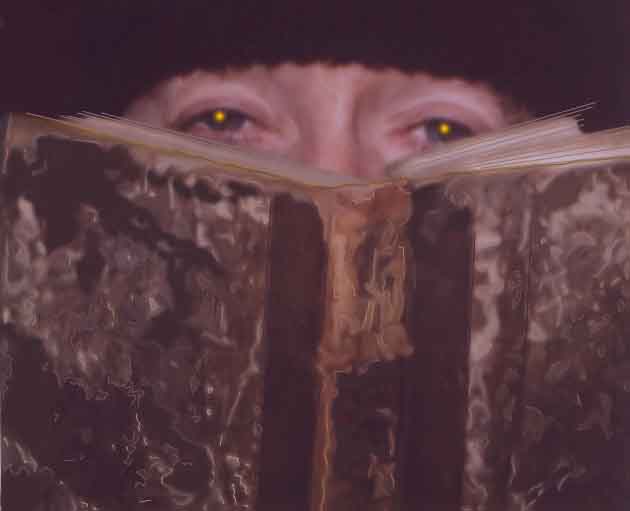









DAVID MILLER'S CLUES AND CUES
[First written as a brochure for Toronto's Lonsdale Gallery in 2000.]
David Miller wants you to trust him (I do). Long after post-structuralism established that the meaning of signs is mutable, Miller implicitly demands that a viewer believe, for example, that what looks like a night sky is in fact a photogram of the ashes of a dead cat, or - even more improbably - that a shadowy figure of a bird owes its origins to a dead creature found on the grounds of a Holocaust site.
Miller's art partly addresses a problem of authenticity that bedevils all seekers of historical truth, whether they are artists or not. He creates beautiful, large, painterly photographic images, and makes the claim that they are based on the most empirical, and hence verifiable or refutable, of facts. The Holocaust dust Miller uses to make photograms either is or is not Holocaust dust - take it or leave it. I believe that Miller is not interested in merely evoking the Holocaust in poetic images; nor, obviously, does he want to speak to suffering by means of a visual narrative; nor, it seems, is he interested in railing against injustice by making visual propaganda. What you see is a kind of artistically-rendered evidence that an artist has gotten from the world and which he delivers right back into your face.
These works, although photographic, are paintings because they behave like paintings. A photogram fixes a gesture as a shape and flattens an object. It also drains an object of colour (which Miller adds back to his work in spades). Although a photogram is as reliable an indexical mark as a tire track is of a tire, a photogram turns information into reductive clues.
This work especially recalls mid-century painting. Robert Motherwell came immediately to mind as I recently looked at Miller's work at Plug In Gallery in Winnipeg. Motherwell's era, in which the ideology of the expressive mark and authentic gesture were so important to "high brow" art was also, of course, the era of the Holocaust. Motherwell's "Elegies to the Spanish Republic" (begun 1949) addressed the problem of art and historical truth. They are tributes to the opponents of Franco and their pre-War anti-fascist struggles in Spain. Miller's elegies, by contrast, are being shown as Holocaust survivors are dying of old age - soon they will be unable to refute Holocaust deniers with living breath - and as our complacency about old victories against fascism are shaken daily by new atrocities.
Like Abstract Expressionist paintings, Miller's stylistically manipulated photograms have a joyous, celebratory aspect that plays against these more somber qualities. Miller's clues - the shape of dirt, a stick, some leaves, a stone - do not give a viewer any more information about the Holocaust than do many of the actual sites that are now overgrown and derelict. This art is for people who have an historical consciousness and some knowledge. Ironically , given the empirical basis of this work as a group of factual souvenirs, Miller's work seems to encourage deep contemplation only in people who have already thought seriously about the Holocaust. Like Motherwell's Elegies, Miller does offer not clues so much as cues to contemplation. I should put it his way: "clues" for viewers who do not trust Miller, and "cues" for those who do.
- Cliff Eyland

|
|